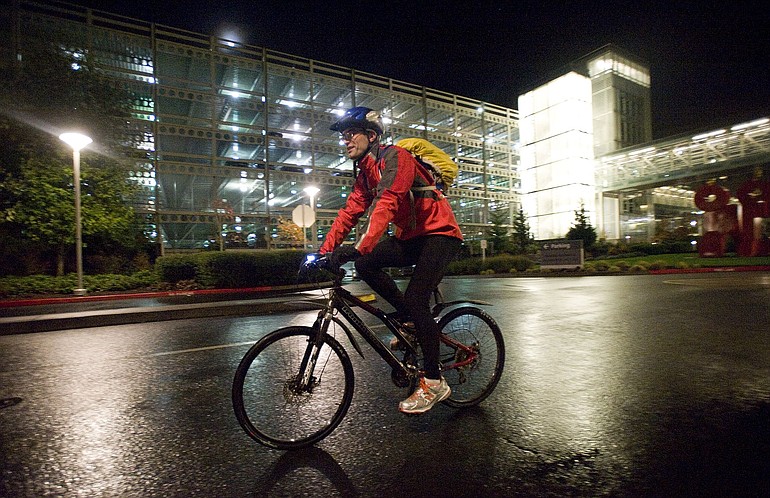o Clark County’s popular trails include the Burnt Bridge Creek Trail, the -Padden Parkway Trail and the Salmon Creek Greenway Trail.
o The county has 26 miles of shoulder bikeways and 43 miles of bike lanes.
o In 38 years, the county has adopted two bicycle plans but no pedestrian plan.
Four days a week, Felida resident Gerald Bliege commutes by bicycle to his job in the imaging department at Legacy Salmon Creek Medical Center.
Although he doesn’t have a bike lane for portions of his commute, it doesn’t faze him. He said he has a healthy amount of fear about sharing the road.
When he’s riding along the shoulder of a road, particularly in the dark, “a lot of drivers are courteous and move over,” Bliege said. “They’ll give me plenty of room. I feel pretty safe.”
o Clark County's popular trails include the Burnt Bridge Creek Trail, the -Padden Parkway Trail and the Salmon Creek Greenway Trail.
o The county has 26 miles of shoulder bikeways and 43 miles of bike lanes.
o In 38 years, the county has adopted two bicycle plans but no pedestrian plan.
Bliege, 36, does drive to work Fridays. That’s to give his legs a rest before the long runs he does on Saturdays in preparation for his second ultramarathon.
In transportation lingo, Bliege is a “Type A cyclist,” said Laurie Lebowsky, a Clark County transportation planner.
He’s dedicated enough to make a cycling commute work, even if it’s less than ideal along some portions.
Now, the county’s looking to attract the “Type B” cyclists, people who are interested in bicycling or walking but want safer routes, Lebowsky said.
At the county commissioners’ weekly meeting, 10 a.m. Tuesday at the Public Service Center, 1300 Franklin St., there will be a public hearing on a proposed Bicycle and Pedestrian Plan.
The 20-year plan outlines ways to improve biking and walking conditions, prioritizes routes and suggests funding ideas.
Lebowsky, who was one of 23 members of a Bicycling and Pedestrian Advisory Committee that worked on the plan, said the county wants to find ways to promote cycling and walking for commuting as well as just for fun.
Ideas include: integrating bike lanes and walking paths into new road construction; encouraging grocery stores and farmers markets to locate along existing bike and pedestrian corridors; developing an east county scenic tour; and providing trails that link downtown areas with schools and parks. In a county known for suburban sprawl, the plan marks the first formal acknowledgment of a need for safe nonmotorized transportation since 1996.
Prior to 1996, the last county plan that addressed the need for safe bicycle routes was written in 1972.
The county has never dedicated a plan to making safer pedestrian routes.
There’s no money set aside to start implementing the plan, but having one in place makes it easier to apply for grants, Lebowsky said.
“The county wants to be in the position to have projects in place should funding be available,” she said.
The top priorities for bike lanes include stretches of Northeast Delfel Road, Northwest 21st Avenue and Northeast 179th Street.
When the county started work on the plan, which worked off the Vancouver-Clark Parks Department’s Regional Trails and Bikeway Systems Plan, the county commissioners were Betty Sue Morris, Marc Boldt and Steve Stuart.
Morris retired in 2008 and was replaced by Tom Mielke, who gave the plan a lukewarm reception during a Nov. 3 work session.
Mielke, a former state legislator, brought up an unsuccessful bill he introduced in 2003.
In House Bill 1975, Mielke and three other lawmakers proposed that cyclists register their bikes and pay a fee no higher than $15.
Cyclists would have to carry proof of registration and identification; the bikes would have license plates that would be smaller versions of motor vehicle plates.
The registration fees would go into a state fund.
“No county, city or town shall construct any lane solely for the use of bicycles … except using grants awarded by the (transportation) department from the bicycle lane construction account,” the bill read.
Mielke asked Lebowsky if she considered the ideas outlined in his proposed legislation.
She did, she said.
She said members of the advisory committee didn’t want to do anything, such as charging fees, to discourage people from riding bicycles.
Mielke, who owns nine cars and has six of them licensed (the others are in storage), said he pays motor vehicle fees and those don’t discourage him from driving.
Mielke reiterated his belief that bicycles ridden on arterial roads should have license plates because “there’s no accountability” when bicyclists disregard traffic laws.
There’s no way to identify the cyclists, he said.
“Those Speedos they wear don’t have pockets,” Mielke said, in a reference to bicycle shorts. “That’s the reason they give for not carrying ID.”
Lebowsky said she wasn’t discouraged by Mielke’s remarks.
“I don’t think it’s a secret that he believes in user fees, in general,” she said. “That’s consistent with his philosophy.”
As for the funding proposals in the plan, those include creating a Transportation Benefit District, establishing a voluntary fund for retrofitting streets with bike lanes or exploring partnerships with the private sector in addition to applying for grants.
Stephanie Rice: 360-735-4508 or stephanie.rice@columbian.com.



